Tesla, Inc. is a U.S headquartered Multinational Corporation that makes fully electric vehicles, energy generation and storage systems, and also sells solar electricity.
Founded in 2003, by Martin Eberhard and Marc Tarpenning, the company was named after electrical engineer and physicist Nikola Tesla.
Tesla become the first American automaker to go public since Ford in 1956. The July 2010 IPO was a success as the company raised $226.1 million and shares surged 41% in their first day of trade.
According to Tesla they are the world’s only vertically integrated sustainable energy company, offering end-to-end clean energy products, including generation, storage and consumption.
Tesla currently produces three fully electric vehicles, the Model S sedan, the Model X sport utility vehicle (“SUV”) and the Model 3 sedan.
The Tesla Semi, an all-electric Class 8 semi-trailer truck, was unveiled at a press conference on November 16, 2017. Production is slated to begin in 2019.
Tesla unveiled the 2020 Roadster, at the end of the event that introduced the Semi.
In February 2018, Tesla announced that they would unveil Model Y production plans within the next 3-6 months. Tesla announced in August 2017 that Model Y will be built using the Model 3 platform.
As of December 31, 2012, Tesla had delivered approximately 2,450 Tesla Roadsters to customers in over 30 countries
Manufacturing Facilities
Tesla manufactures vehicles primarily at facilities in
Fremont, California
Lathrop, California
Tilburg, Netherlands
Gigafactory 1 near Reno, Nevada.
Solar products at factories in
Fremont, California
Buffalo, New York (Gigafactory 2)
Manufactures energy storage products at
Gigafactory 1
In its fourth quarter 2016 investor letter, Tesla said that the company is planning to finalize locations for Gigafactories 3, 4 and possibly 5. The first Gigafactory Tesla has been working on is a $5 billion investment.
“In the future, all Gigafactories will include vehicle production. So, right now, vehicle production and battery production, like battery production and motor and power electronics and charger production are at Giga, and then, we have our Fremont car factory. But future Gigafactories will all incorporate vehicle production.” said Elon Musk during first quarter 2018 earnings call
Tesla Worldwide Sales
Tesla’s worldwide sales crossed 100,000 units in Q4-2015 , 200,000 in Q1-2017 and 300,000 in Q1-2018.
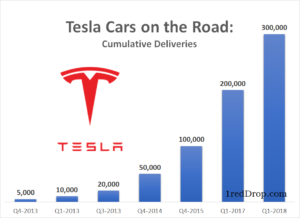
As of March 2018, Model S remains the top seller for Tesla with global sales of 224,590 units between June 2012 and March 2018, followed by Model X with 82,129 units between September 2015 and March 2018, and Model 3 with 9,950 units between July 2017 and March 2018.
The discontinued Tesla Roadster sales stands at 2,450 units.
The United States remains the largest market for Tesla, followed by China and Norway. These three markets accounted for 72.8% of Tesla’s sales in 2017.
United States: Tesla remains the top EV seller in United States. Tesla Model 3 was the top selling EV in United States with 12,055 shipments between January and April 2018, followed by Toyota Prius Prime at 9,094, Tesla Model S at 6,550, Chevrolet Bolt EV at 5,650 and then Tesla Model X at 5,525. Tesla expects to hit 200,000 units sales in United States this year(2018) , which will trigger the phase out of US Federal Tax Credit.
Federal Tax Credit US: Once an EV manufacturer reaches 200,000 units sold in the United States, the quarter that happens as well as the following quarter gets full tax rebate of $7,500. The credit is reduced to $3,750 for the next 6 months, then to $1,875 for the next 6 months and then it expires completely. (L) (Energy.gov)
China: In 2017, Tesla doubled its sales in China to over $2 billion, after tripling sales in 2016 compared to the year before.
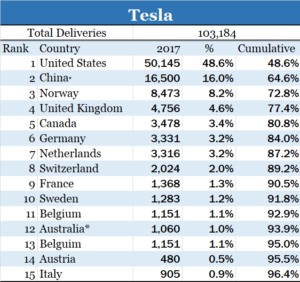
Australia: According to Australian Financial Review, Tesla Motors Australia tripled its revenue to $160.7 million in 2017, compared to $52.6 million in 2016. (L) Tesla held nearly 50% of Australia’s EV marketshare in 2017.
Germany: Tesla continued to struggle in Germany as the company sold just 3,331 units in 2017, where total new car registrations for the year touched 3.44 million units. (L)
Tesla Guidance: Tesla expects to deliver 100,000 Model S and Model X in 2018. Tesla targets peak production of 5000 Model 3s per week in June, 2018 and 6000 in July, 2018.
Tesla Supercharger Network
Tesla Superchargers are a network of 480-Volt, 145 kW capacity, fast-charging stations built by Tesla, Inc. exclusively for Tesla customers. The superchargers deliver DC power directly to the battery bypassing the car’s on-board chargers. Although the Superchargers are technically capable of 145 kW, Tesla cars restrict the power to 120 kW.
Supercharger stations typically have between six and twenty Superchargers. Use of the Supercharger network is either free or requires a small fee.
According to Tesla, each year, owners receive 400 kWh of free Supercharger credit, enough to drive about 1600 km. Customers who travel beyond the annual credit pay a small fee to Supercharge.
Tesla has been working on next generation V3 superchargers for more than a year now. The company is planning to unveil its next generation superchargers this year (2018).
As of June 23, 2018 Tesla had 1,261 supercharger stations with 10,021 superchargers across the world. Tesla unveiled its Supercharger network in September 24, 2012, (L) Six locations in California were unveiled during the event and two more were added in the East Coast by the end of 2012.
Supercharger Growth
Tesla Service
Unlike other automakers who operate a traditional franchised distribution network, Tesla own its sales and service network.
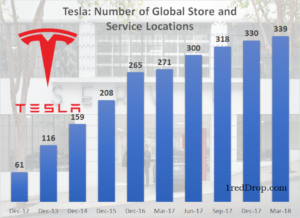
Tesla uses a mix of over-the-air updates, remote diagnostics, mobile service technicians and service centers to service and repair Tesla cars. Tesla recommends an annual service inspection every year or 20,000 km, whichever occurs first.
Tesla vehicles are designed with the capability to wirelessly upload the data to Tesla via an on-board system with cellular connectivity, allowing Tesla to do remote diagnosis. Tesla also says that its cars are designed so that most repairs can be done without raising the car on vehicle lift.
According to Tesla, 80% of repairs are minor and it can be done remotely saving customers the time travelling to and from a service center.
Tesla global store and service locations increased from 61 locations in December 2012 to 339 locations in March 2018. Number of mobile service vehicles increased from 160 to 350+ between September 2017 and June 2018.
“Tesla says it has 47 robots deployed in scanning stations throughout the body line. They measure 1,900 points in every Model 3 to match them to design specs—with a precision of 0.15 millimeters. Torque measurements are also automatically recorded for every bolt that’s fastened. During the final test drives on the track, sound recorders measure squeaks, rattles and wind and road noise that a test driver might miss. All of this data is stored with each car’s unique Vehicle Identification Number, or VIN, so service centers can trace any issue back to a root cause in the factory. The idea is that Tesla will be able to improve its cars, even after they’re in a customer’s driveway. ” – Bloomberg
Tesla Employees
The number of employees working at Tesla increased from 514 to 37,543 between December 2009 and December 2017. The number of employees more than doubled in 2017 from 17,182 in 2016 to 37,543 in 2017 primarily due to Tesla’s acquisition of SolarCity.

At the end of 2015, SolarCity had 15,273 employees and it was reduced to 12,243 employees at the end of 2016.
CEO Elon Musk announced in June, 2018 that Tesla will cut 9% of its workforce as part of its reorganization. The job cut is expected to impact only salaried positions and not production associates. (L)
Tesla’s workforce is considerably smaller than large auto companies like GM, Ford, Toyota, BMW and Daimler.
Strength of workforce in 2017
Toyota: 364,445
Daimler: 289,321
Ford: 202,000
GM: 180,000
BMW: 129,932
Tesla’s Worldwide Revenue
Tesla’s revenue grew from $14.74 million in fiscal year 2008 to 11.8 billion fiscal year 2017. Tesla is one of the fastest companies to reach $10 billion in annual revenues. Tesla has kept the pace with some of the fastest growing companies of our generation like Facebook and Amazon.
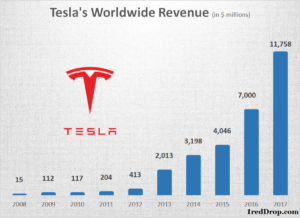
Tesla reported $14.74 million in annual revenue in fiscal 2008 and it took Tesla nine years to cross the ten billion dollars milestone in 2017. Facebook took eight years to increase revenue from $153 million in 2007 to $12.4 billion in 2014. Amazon took ten years to increase annual revenue from $15.74 million in 1996 to $10.71 billion in 2006.
Tesla is still a small company in terms of revenue when compared to large automakers like General Motors, Toyota, Ford, Daimler (Mercedes-Benz) and BMW.
Tesla’s competitor Mercedes-Benz reported annual revenue of €94.7 billion in 2017, while BMW reported €98.678 billion.
Bagikan Berita Ini

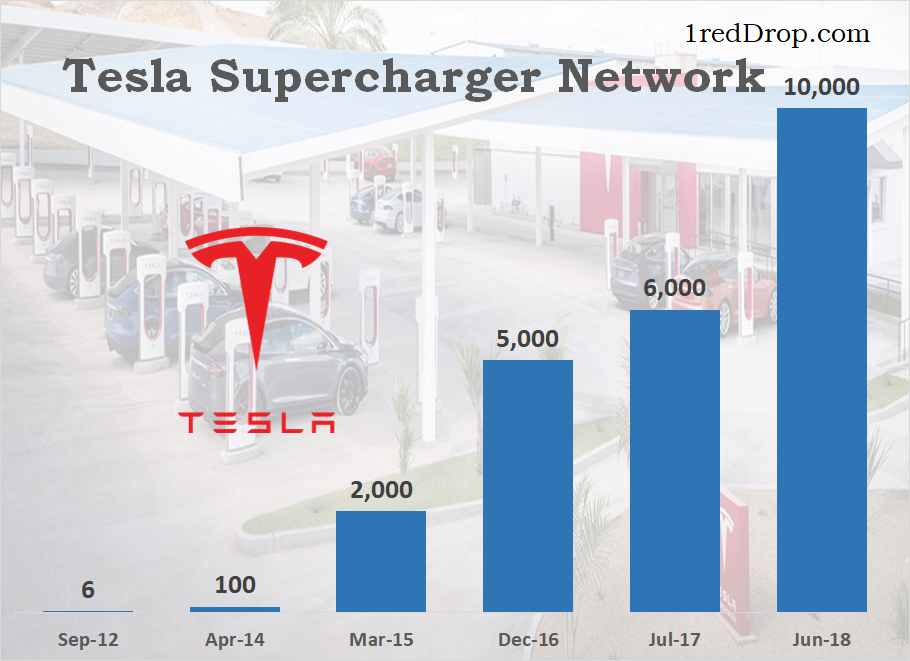














0 Response to "Tesla, Inc."
Post a Comment